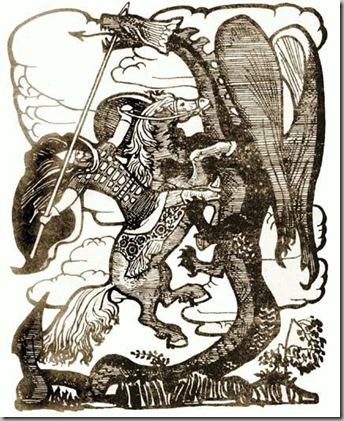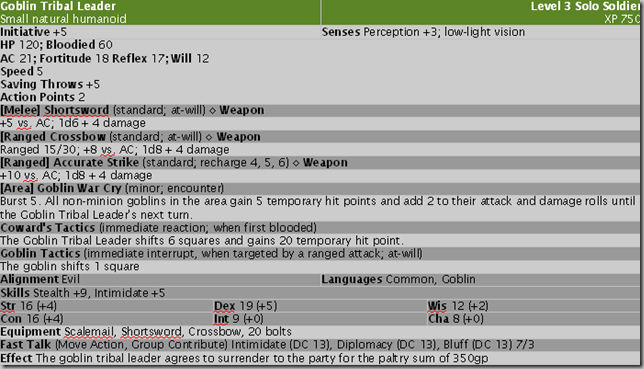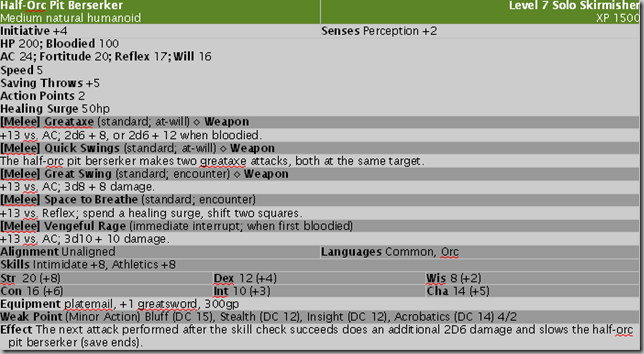 One of the greatest advantages D&D 3.5e has over D&D 4e is the implied set of options available in combat. D&D is a very good RPG system for combat, and has always excelled in that field.
One of the greatest advantages D&D 3.5e has over D&D 4e is the implied set of options available in combat. D&D is a very good RPG system for combat, and has always excelled in that field.
3.5e introduced the flood of classes and races that we are all (I'm sure) familiar with. Each had a few unique mechanics, and each added it's own subtle layer to combat. Psionics would add an aspect to combat that fighters and wizards didn't have. Swordsages too. Each splatbook added a few new feats, classes, and thus a new dimension to combat.
4e, many complain, is designed to codify combat into a series of a similar actions. Your at-will, encounter and daily powers limit your character's capabilities, and thus your ability to be creative in combat.
In 3.5e, a tavern brawl might include kicking tables over, striking enemies with chairs, throwing mugs of ale (hopefully empty!), climbing under tables, hiding behind the bar, putting out torches to escape, and many more creative options. In 4e, you can Cleave or you can Reaping Strike. It feels like the game has had a lot of options sucked out.
Now, any good 4e advocate will tell you that it's nothing like that at all - in fact, they've properly set out damage according to level with a handy table in the DMG!
But something about powers smacks of “you're limited to using this, except in special cases”. And it's at least partially true - powers will suffice for most combats.
But the encounters I'd like to focus on are the epic ones - the ones where you're meant to think outside of the box. Solo encounters are the “boss fights” of 4e. They're meant to be hard. The potential for a TPK is meant to be an ever-present concern. And detractors from 4e point out that solo encounters are long, often monotonous as characters drop all their daily and encounter powers, then rinse-repeat at-will powers until one side dies.
This blog post is about proposing a new mechanic for solo encounters, inspired by computer games and novels.
Introducing the Use of Skills in Combat
Combat is described as a whirling mass of chaos - dodging, feinting, observing your opponent. The single discrete dice roll represents not a single strike, but a number of possible attacks - all the fighting that can happen in a six second round.
But a thinking warrior can make creative use of those six seconds. By combining non-combat actions with their normal offensive repertoire, they can “think outside of the box” and create opportunities in combat. In fighting computer games (particularly the FPS and 3PS fighting genres), we often see boss combats that are impossibly hard until an indirect attack is performed - sometimes, this will be a way to do additional damage, sometimes this will make the boss vulnerable for a short period of time.
By introducing skill challenges into combat encounters, we can inject the reward for out-of-the-box thinking in too.
Obviously, the skill challenges will be context sensitive. If we introduce the idea of “climbing” a dragon (a series of athletics or acrobatics skill checks) to access a vulnerable spot, we cannot hope to apply the same mechanic to fighting a solo unique kobold. Using intimidate to cow the kobold into weaker attacks might work, but it wouldn't be successful against a bloodthirsty hill giant solo creature.
So instead, I propose adding skill challenges directly into monster's information block - unless the skill challenge is specific to a locale instead of a monster. Climbing a cliff (athletics skill check) to get a better shot with a bow would have to be dealt with by a canny and flexible DM.
The format I propose for altering monsters stat blocks is to add an extra section when describing the monster, below the “equipment section”. In it, the skill challenge will be listed by an emboldened skill challenge name (to hint to a DM how the skill challenge applies), followed by a comma separated list of skills relevant to the skill challenge, with an associated DC in brackets adjacent to the skill. The list is followed by two numbers divided by a slash, indicating the number of success or failures required to conclude the skill challenge. Finally, the word “Effect:” followed by the result of a successful skill challenge will be listed.
The initial concept for the skill challenges was to suggest that a skill challenge attempt was a move action, and each was isolated to individual characters (so characters could not contribute to other's skill challenges). This model was too simple, but the range of capabilities were diverse enough that - barring a few guidelines - it would be impossible to describe the full range of options. Instead, a power-like set of keywords and descriptors can be added to the skill challenge, but DMs have the choice of overriding these keywords should they wish to.
Some Examples
Here are some examples, using NPCs I've generated for various campaigns:
“We can give you gold! [Diplomacy]” , Gottfried exclaimed as he dodged the shortsword, firing (and killing) a distant goblin. “Your comrades have abandoned you, and we have no need to finish this battle. [Intimidate] Lay down your sword and walk away”, ducking below a broad swipe. “Your kin have abandoned you, you have no reason to continue fighting [Bluff]”, Gottfried's words finally struck home. The goblin hesitated for a moment, and Gottfried continued “My friends and I stand victorious - there is no need for this to end in more bloodshed”. The goblin grunted. He turned to one side, shoved his shortsword six inches into the tree they had been fighting under, grabbed the pouch from Gottfried's belt... and walked away.
Comments:
Obviously, the ability to end combat with words is powerful. There are already intimidate rules - but, especially for notably cowardly creatures, the ability to undermine their confidence should not only be at the end of a combat. Note the “Group Contribute” keyword indicates that more than one character can contribute to the skill challenge.
Hunter circled the half-orc in the ring. The bastard's great axe had pulled a chunk out of his chest-plate in one great swing, and he was not taking any more chances. He thought he saw an exposed joint in his armour - if he could just find an opening. As the pit fighter took a moment to raise his axe for another swing, Hunter side-stepped, jamming his sword-blade into the exposed point - his reward showing in the red now tarnishing the sword-tip and the limp the half-orc moved with.
Comments:
One obvious option for skill challenges is additional damage. Several prominent D&D commentators have mentioned how solo creatures have too many hit points and several have recommended reducing them. An alternative is to open additional mechanics that allow extra damage to be dealt by the party.
Note that unless specified, a single character must perform all skill checks - unlike the goblin above, there is no “Group Contribute” keyword. Note also that some skills can have different DCs.
Finally, the “stealth” check above should only apply when stealth is a viable option. DMs should use their discretion when allowing skill checks in these scenarios. A darkened room with multiple combatants might allow for stealth - a one-on-one pit fight would not. The skill challenge is still available - but it cannot be achieved by stealth skill checks.
Finally, I would like to look at dragons as the most fun (and awesome!) example. I won't reprint any of the dragons from the Monster Manual, but the following can be appended on to the “Adult Red Dragon”, described on page 83 of the MM.
Daranis shoved his sword into the thigh of the dragon. Raven Queen's touch, this scaly hide was thick! He put a boot against it, even as the creature roared in pain, and blinked a few feet up, again jamming the sword into a gap in the scales. Muscles straining he dragged himself up on the dragon's back, green flames licking the edge of the blade as he charged it with arcane power. Struggling as the beast tried to throw him off, he had to relinquish his precious bag of trophies to keep from being thrown. Eventually reaching behind the creature's head, he mustered all his power and struck a great blow to the base of the skull - the creature reared up in agony, finally dislodging him from it's back.
Comments:
The “Climb to the Head” skill challenge uses “Attack” as a skill. In this case, the player is literally jamming a weapon into the dragon to gain purchase on the slippery scales. If the DM allows, the player may add the weapon's bonuses (proficiency, magic, etc.) to the roll. Note that the “free critical hit” does not apply the effects of weapons which give bonuses on critical hits.
The “Weak Point Underneath” skill challenge allows a player to get beneath the dragon - a dangerous endeavour - and stab the dragon in a weak point under the leg, crippling it. The “vulnerable” keyword means that while attempting this skill challenge, from the first time the player rolls until it is completed (in success or failure) the player has a -2 penalty applied to their defenses. The “Insight 1 required” means that at least one of the successful skill checks for this skill challenge must be an Insight check, to represent the player noticing the vulnerable point.
General Guidelines
Some good general guidelines for using skill challenges in solo encounters:
-
Find the associated defense for the skill applied, and use that for the DC. Acrobatics is normally countered by Reflex, Diplomacy by Will, etc.
-
Part of the fun of this system is in it's novelty. Switch the ideas up, try new ones. Good DMs can forego adding to the stat block entirely by using the system “off-the-cuff”, letting their players invent new skill challenges as they want - with the DM's approval (of course!)
-
Players should (preferably) not be informed of the skill challenge. It may be hinted at (your character notices some exposed points in the enemy's armour), but it shouldn't be “given away”.
Final Words
If these mechanics and concepts sounds familiar, it is possibly because they were inspired by Iron Heroes, which introduces the concept very well. The idea of mixing up combat and introducing novel sequences can add a lot of flavour to combats, and allow players to have equally long, but much more memorable, solo encounters.





